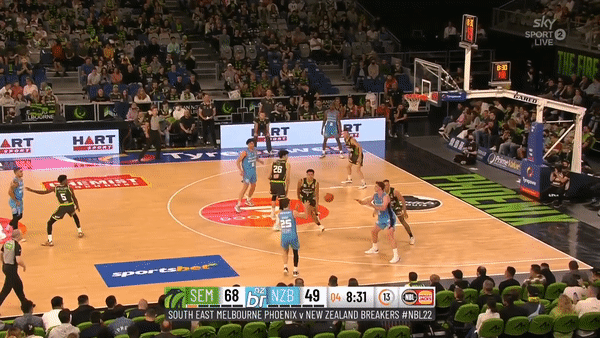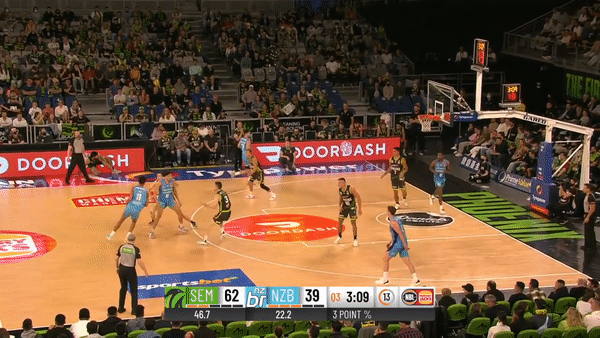Ousmane Dieng and Hugo Besson Debut Game Notes
Written by Tim Smith
In what was the biggest historical loss in a New Zealand Breakers regular season opener, there were a pair of bright spots with NBA futures making their debuts for the losing side. Ousmane Dieng and Hugo Besson, who were played almost interchangeably, struggled from the floor, but each had many moments worthy of discussion in the scouting world.
On a quick side note, this matchup featured several former NBA players, speaking to the growing strength of the NBL. Those former NBA players were Zhou Qi, Xavier Munford, Mitch Creek, Ryan Broekhoff, Peyton Siva, and Jeremiah Martin.
Link to the game box score: 04/12/21
Hugo Besson, PG/SG | Height: 6’3” | Weight: 196 lbs | Draft Age: 21.2
Draft Projection: Early Second Round
Statline: 18:46 MIN | 10 PTS | 2-7 FG | 2-3 3PT | 1 RBD | 2 AST | 3 TOV | 0 STL/BLK
During the majority of his run in the first quarter, Besson didn’t see many touches, let alone on-ball opportunities. This was the case until Jeremiah Martin found Besson spotted up on the high wing in semi-transition to drain what will hopefully be the first of many threes.
During his season debut, Besson showed great defensive engagement, usually guarding the Phoenix’s opposing off-guard and subsequently not being tasked with many on-ball defensive assignments. However, Besson was actively tagging off-ball movers and tracking his own man.
Besson received several on-ball reps to close out the second quarter following his limited responsibility start to the game. Besson comes off the Galloway screen in the play below, gets the downhill switch onto Zhou Qi, and gets walled off at the rim. Sure, Qi is not an easy assignment at the rim, being 7’1” with a near 9’5” standing reach. However, Qi becomes and continues to be a rim deterring problem for Besson, and Besson did not consistently do a good job of finding a solution to this or an alternative way to be effective.
It is fair to assume Besson may have been attempting to draw a foul call here, leaping into Qi’s verticality relatively early. However, Besson has shown high-level balance as a pull-up shooter and the ability to pull up on a dime in such scenarios while playing in the French Pro B, and he does not utilize that here.
I’d like Besson to recognize his personnel and draw bigs like Qi into space, either catching them off-balance and rising for the easy two, or kicking out upon the collapsing defense. This is an obvious nitpick, but recognising and creating advantages off of PnR switches is key to Besson’s on-ball progression.
New Zealand are one of the more oddly constructed NBL teams, especially in their backcourt, and I’m not convinced that this is a recipe for success. Besson was predominantly played in three-guard lineups, consisting of an assortment of Peyton Siva, Jeremiah Martin, and William McDowell-White. I am slightly concerned about the amount of on-ball reps Besson will get throughout the season from a development standpoint. Even as a spot up option, the backcourt spacing for the Breakers is less than ideal and an over-reliance on Besson as one of their few legitimate spacing options, especially when Finn Delany is having an off-night, could lead to his actual impact in this area being shadowed and misrepresented. This will be an aspect to keep an eye on, particularly in lineups featuring McDowell-White, Martin, and Besson.
The following on-ball possession was an improvement to his last. Here, Besson gets a stride advantage on Le’Afa and delays dropping it off to Galloway until he has Qi turned towards the baseline. The extra cradled step he makes is an encouraging sign of feel for manipulation, as it allows for the open lane for Galloway.
Besson’s first-half possessions gave me the impression that it will take a few games for him to settle in. Besson gets Le’Afa on his hip off the high ball screen and rises for a midrange miss with an awkwardly set shot base. Besson recognizes Qi in drop but seems rushed and partially indecisive in pulling up, as seen by his unset base, which looks halfway between a jumper and a floater. This appears to be in response to Qi’s defensive presence.
Finally, Besson starts making use of landing the switch onto Qi, getting the big on an island and earning a trip to the charity stripe. Besson shot one for two from the line here but shot 79% from the line in the French Pro B.
While not an overly complex read, this is a great one nonetheless. With Saint-Quentin, Besson played in the pick and roll at a controlled pace, drawing out the defense with his dribble, waiting until an opening unfolds. Here, Besson does precisely that, keeping Creek engaged while waiting for Qi to tag Loe on the roll and leave Le’Afa (6’2”) scrambling to switch onto Delany (6’7”).
Once again, Besson finds Qi marking him and confidently guns it from just above the top of the key. Following this shot, Besson missed the three after getting another switch off of a screen and a shade of space.
Nerves were a factor throughout the game for Besson, as he never looked quite settled handling the ball. On one baseline inbound play, Besson’s defender picked the ball loose, and Besson recovered and panic-dribbled to the sideline in which he stood out. A similar moment happened later in which Besson overdribbled rather than slowing the game down for himself. I don’t see Besson’s ball-handling under pressure as a long-term concern as of right now. However, if these lapses are still present ten games into the season, they might be worth thinking over.
In the next clip, Besson gets to the basket off a pick and fade play but gets swallowed by Qi (again!) amidst a concerning lack of court awareness. Sure, Besson initiates contact with Creek, giving him enough daylight to theoretically get the shot off, but Besson forgets about the roaming seven-footer that has caused him problems all night. Whether it is a communication breakdown, a one-off early-season hero-ball moment, or a legitimate game sense issue when attacking the basket, this sort of play is something of note to monitor.
Similarly, here, Besson gets seriously bothered by the length of South East Melbourne’s frontcourt. In fairness to Besson though, there is not much else he could’ve done here after getting downhill (minus a kick to the corner, which he couldn’t see). New Zealand’s poor spacing certainly doesn’t help him much in this instance.
Ousmane Dieng, SF | Height: 6’10” | Weight: 185 lbs | Draft Age: 19.1
Draft Projection: Late Lottery
Statline: 20:55 MIN | 3 PTS | 1-7 FG | 0-4 3PT | 0 RBD | 2 AST | 3 TOV | 0 STL/BLK
Oddly, the first note I took was that Dieng was active in competing for boards despite finishing with zero rebounds. Ultimately he was out-muscled and out-positioned on each attempt which is concerning considering his height advantage. However, the takeaway from this is that the engagement and focus on securing defensive possessions were there.
Now, I’m not going to discuss all of Dieng’s misses (particularly his threes) to the extent of Besson’s. None of his misses from deep are of clip-worthy importance from an analysis perspective as all four were clean corner catch-and-shoot looks that rimmed out. In addition, Dieng spent most of the game camping in the corner. This is less of a problem of off-ball movement and instead a coaching decision as the Breakers have had limited engagement in off-ball movement over the past few years.
Back to the clips, Dieng actively sought out position to attack closeouts. Here, he takes advantage of a great opportunity to do so in semi-transition against Smith-Milner. An apparent mismatch on the wing from the get-go, Dieng uses his long strides to secure a deep paint touch, lure in the help defense, and find Galloway with a patiently timed drop-off pass which sends him to the line.
Dieng scored his first and only field goal of the game on a nice baseline cut after filling the far wing lane in transition. It is encouraging to see him opt for the layup considering New Zealand’s corner camping tendencies.
New Zealand primarily ran Dieng as a decision-maker in high ball handoffs when not spotting up in the corner. In doing so, the Breakers were best utilising Dieng’s combination of live dribble playmaking and downhill stride length. Here, Dieng throws a perfectly placed live dribble pass off the handoff/slip screen to Galloway, using his height mismatch forced off the slip screen to execute the feed.
Dieng followed this up with a similar play, coming from the right. Here, Galloway is tagged on the roll by the corner guard, and Dieng recognizes this, patiently dishing the ball to Martin in the corner. While a raw basketball prospect no doubt, flashes like this could indicate some serious potential as a secondary (and potential as a primary given some outlier finishing development) initiator, especially if Dieng continues to progress as a pull-up threat, which isn’t out of the question based on his play with CFBB.
Like most other eighteen-year-olds, Dieng tends to run through the motions at times rather than reading and reacting. However, I wouldn’t consider this turnover punishable as even trending rookie Josh Giddey had some bone-headed moments in his first few NBL games. Below, Dieng misreads the play in what should’ve instead been a ball reversal and turns it over.
Dieng does a great job of getting the defensive stop here on Te Rangi, absorbing contact with his chest while cutting off Te Rangi’s left driving lane by beating him to his spot while also recovering laterally to contest the hook shot.
Regarding his defense, Dieng initially marked smaller guards at the point of attack to begin possessions, often switching onto the nearby forward/big as soon as possible. Dieng had a solid defensive outing, although it wasn’t game-changing, hence the lack of defensive clips. Dieng had one worrying possession where his footwork on the perimeter looked somewhat uncoordinated. Xavier Munford nearly had Dieng turned around after he shuffled leftwards by stepping over with his right foot first, and eventually, he didn’t put a hand up to contest the shot despite a hot shooting night from Munford.
On yet another handoff possession at the top of the key, Dieng used his stride length to get to the rim but got walled off and forced into a soft leaner. Dieng shot an abysmal 34% from the field in France, and most of his finishing struggles can be attributed to a lack of strength and confidence around the rim, which led to a fair amount of awkward leaning shots.
Below, upon attacking the closeout, Dieng shows off with a behind-the-back dribble, which is more flashy than functional as the dribble leads him to no advantage. Dieng settles for a fadeaway, recognising his height advantage but not acknowledging how well contested he is upon rising up. Like the handoff turnover, Dieng is going through the motions on this play with no counter to the defense. This habit of playing through the motions is a relevant detail in assessing Dieng’s development as a shot creator. Early indicators of counter instincts will be an important factor for those personally ranking Dieng in the top seven or so, which I have seen a decent amount of Draft Twitter folk do.
----
If you’re interested in scouting the NBL for yourself, feel free to use my 2022 NBL Prospect Fixture, which includes dates & times (time converted to EST), prospect availability, box score links, and individualized prospect schedules that are continually updated throughout the season.



















